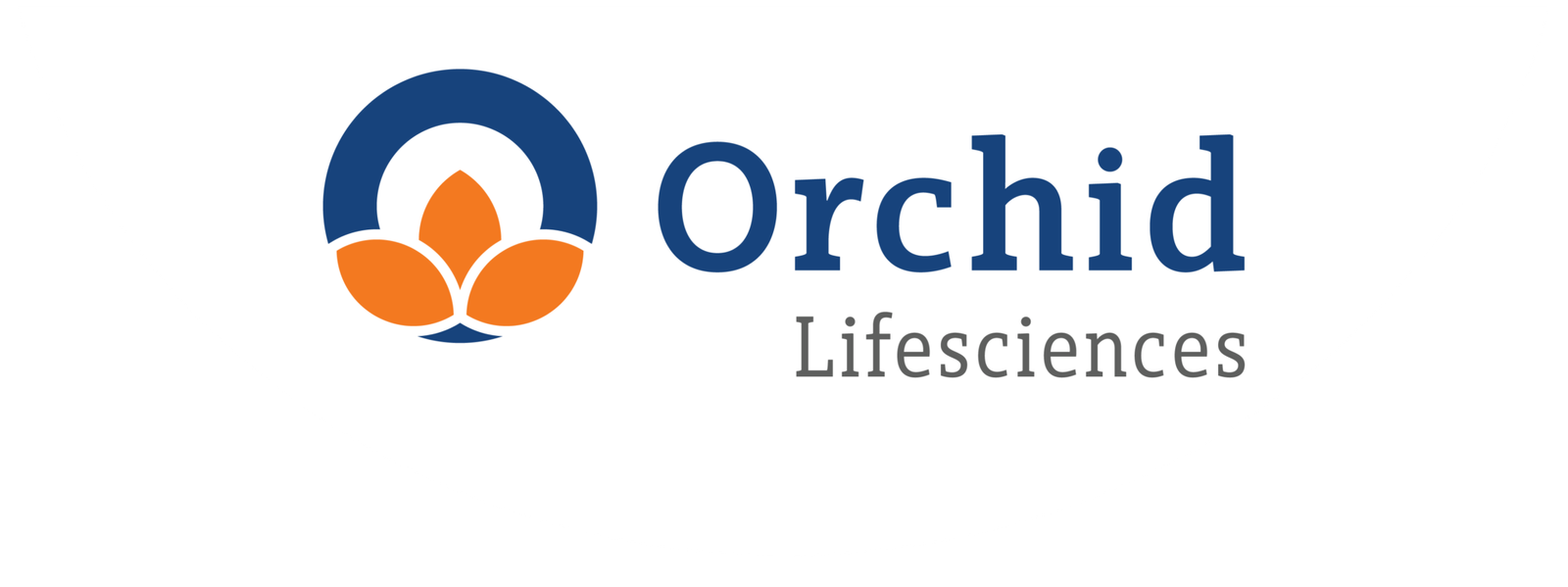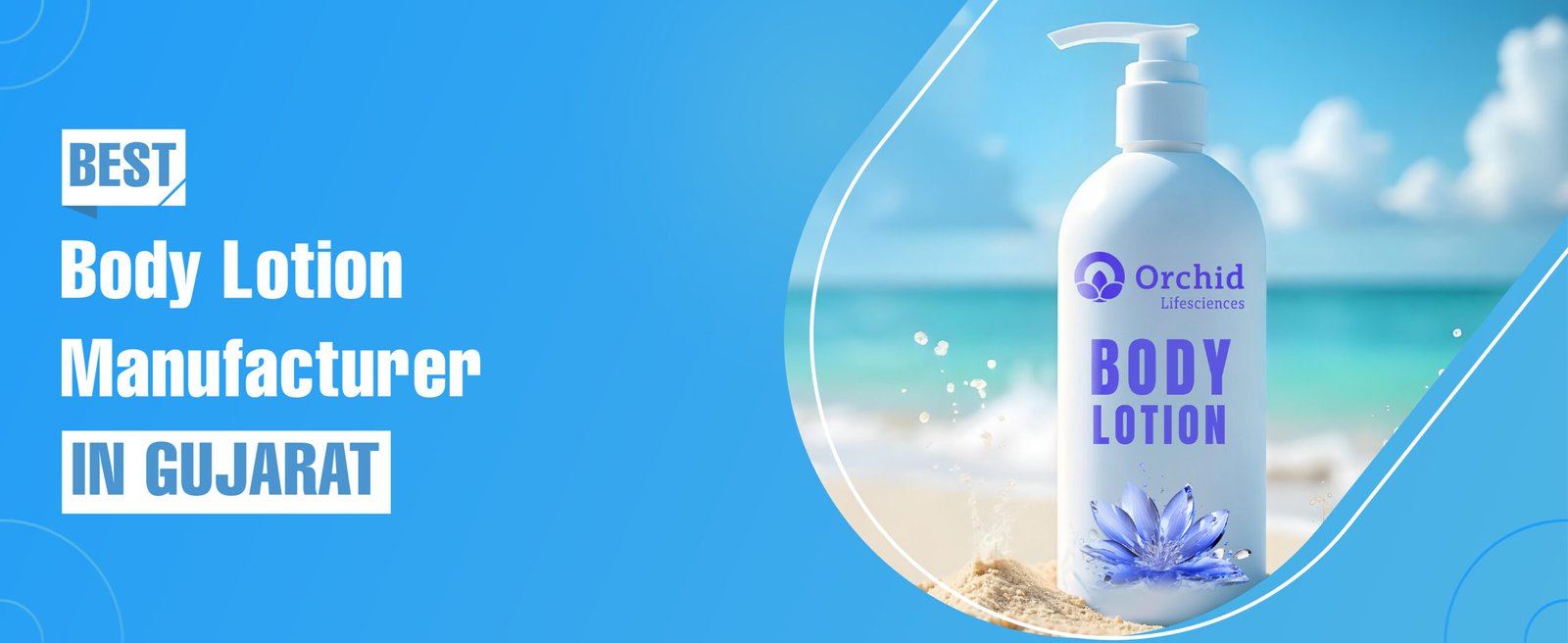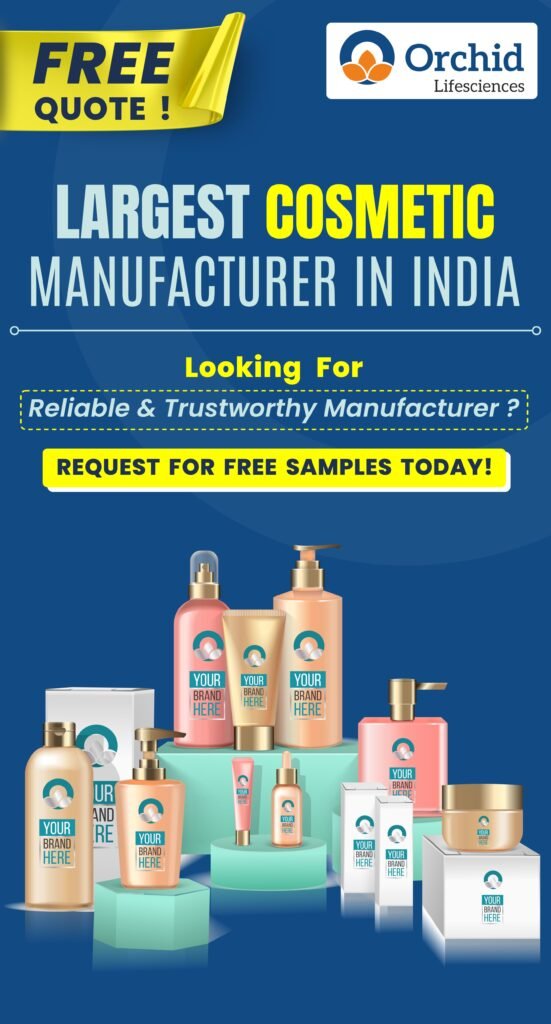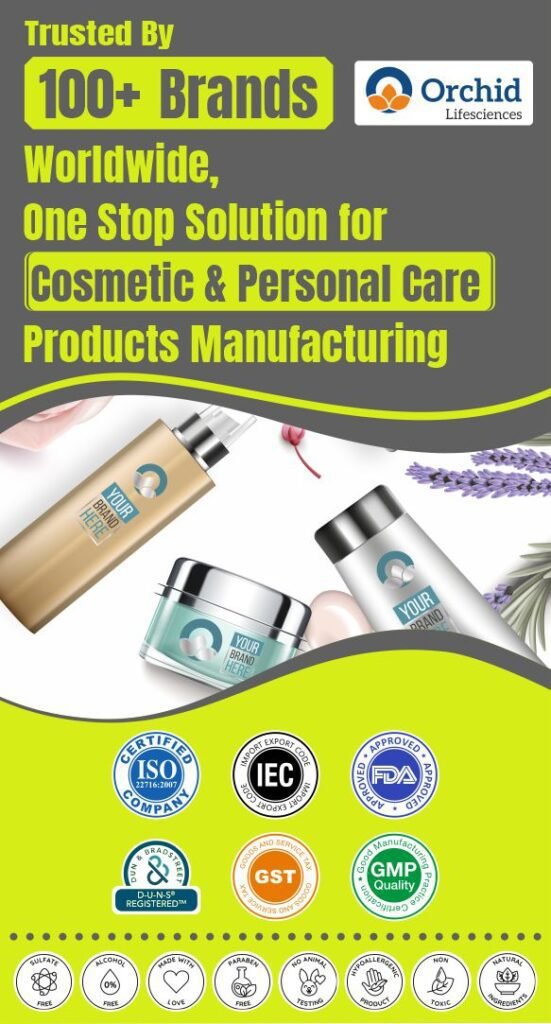Industry Overview: Cosmetic Manufacturing in Gujarat
Historical Significance and Development of the Cosmetic Industry in Gujarat
- Gujarat has long been recognized as one of India’s leading industrial hubs, known for its thriving chemical, pharmaceutical, and manufacturing sectors. The state’s strategic location and robust industrial base have positioned it as a key player in various industries, including cosmetics and personal care products.
- Historically, Gujarat’s industrial growth can be traced back to the 1960s and 1970s when the state established itself as a major center for chemical production. The availability of raw materials, such as essential oils, chemicals, and natural ingredients, provided an ideal foundation for the cosmetic industry to develop.
- Over time, Gujarat’s industrial ecosystem expanded to include skincare and cosmetic products, as demand for personal care items surged in both domestic and international markets.
- In recent years, the cosmetic industry in Gujarat has seen significant growth, with the rise in consumer awareness regarding personal grooming and skincare. The state’s reputation for producing high quality products at competitive prices has attracted investment from both national and multinational companies.
- Gujarat’s cosmetic manufacturers have also increasingly focused on research and development, paving the way for innovative products like herbal and organic skincare solutions.
- This evolution is supported by the state’s strong network of suppliers, efficient transportation systems, and access to global markets through its ports.
Key Factors Contributing to the Growth of Body Lotion Manufacturing
- Several key factors have contributed to the rapid growth of body lotion manufacturing in Gujarat. One of the most important is the state’s well-established infrastructure, which includes advanced manufacturing facilities, access to modern technology, and a reliable supply chain network.
- Gujarat is home to numerous Special Economic Zones (SEZs) and industrial parks, offering manufacturers streamlined access to resources and export incentives. This has enabled local manufacturers to scale their production efficiently.
- Another significant factor is the availability of skilled labor in the region. Gujarat has a large workforce with expertise in areas such as chemistry, engineering, and manufacturing, allowing for the precise formulation and production of body lotions and other cosmetic products.
- Furthermore, the state government has introduced a variety of incentives, such as tax breaks and subsidies, to attract investment in the cosmetic sector. These initiatives have fostered a favourable business environment for manufacturers.
Prominent Locations for Skincare and Cosmetic Product Manufacturing
- Several regions in Gujarat are well-known for their focus on cosmetic and skincare product manufacturing. The industrial cities of Ahmedabad, Vadodara, and Surat have emerged as key hubs for cosmetic production. Ahmedabad, in particular, is home to numerous cosmetic and pharmaceutical companies that specialize in a wide range of products, including body lotions, creams, and ointments.
- Vadodara, with its strong chemical and pharmaceutical base, has also become a centre for skincare manufacturing, attracting both domestic and international firms. Surat, known for its entrepreneurial spirit, has seen a rise in small to medium-scale manufacturers focused on producing organic and herbal skincare products.
- Overall, Gujarat’s well-developed industrial ecosystem, skilled workforce, and government support have made it a thriving center for body lotion and cosmetic manufacturing, positioning the state as a leader in India’s personal care industry.
The Process of Body Lotion Manufacturing
Body lotion manufacturing is a highly specialized process that involves several steps, including raw material sourcing, formulation development, production, quality control, and packaging. Each step plays a critical role in ensuring the final product is effective, safe, and appealing to consumers.
1. Raw Materials: Sourcing of Key Ingredients
The first step in the manufacturing of body lotion involves sourcing high-quality raw materials. The key ingredients typically include:
- Moisturizers: Commonly used moisturizers include glycerin, shea butter, cocoa butter, aloe vera, and hyaluronic acid. These ingredients hydrate the skin by drawing moisture from the environment or locking moisture into the skin.
- Vitamins: Body lotions often contain vitamins such as Vitamin E, Vitamin C and Vitamin A (retinol). These vitamins play different roles, such as promoting skin regeneration, fighting free radicals, and improving skin texture.
- Essential Oils: Essential oils like lavender, chamomile, and tea tree oil are added for their fragrance and therapeutic benefits. They can have soothing, antimicrobial, or anti-inflammatory effects on the skin.
- Fragrances: Synthetic or natural fragrances are used to provide a pleasant scent to the lotion. However, manufacturers need to ensure these fragrances are hypoallergenic and gentle on sensitive skin.
- Emulsifiers: Since lotions are water-oil emulsions, emulsifiers such as cetyl alcohol or glyceryl stearate are essential to ensure that water and oil phases blend effectively without separating.
The quality of the final product heavily depends on the quality of these raw materials. Sourcing ethically produced, non-toxic, and environmentally friendly ingredients is increasingly becoming a priority in modern skincare formulations.
2. Formulation Development: Creating Unique Formulations for Various Skin Types
Formulation development is a critical stage where chemists work on creating lotions suited for different skin types, such as dry, oily, or sensitive skin.
- For Dry Skin: Formulations for dry skin include rich, occlusive ingredients like shea butter, ceramides, and petroleum jelly that create a protective barrier to prevent water loss.
- For Oily Skin: Lighter ingredients such as hyaluronic acid, aloe vera, and non-comedogenic oils like jojoba oil are used in lotions for oily skin to prevent clogging pores and to keep the skin hydrated without greasiness.
- For Sensitive Skin: Products for sensitive skin include fewer ingredients, eliminating potential irritants like fragrances, alcohol, or harsh preservatives. Soothing agents like calendula, oatmeal, or chamomile are commonly added.
During this phase, the product’s texture, consistency, absorption rate, and scent are fine-tuned to meet consumer preferences and skin type needs.
3. Production Process
The production of body lotion typically involves the following key steps:
- Emulsification: In this process, oil and water-based ingredients are combined. This is typically done by heating the oil phase (which contains oils, emulsifiers, and sometimes waxes) and the water phase (which contains water-soluble ingredients like humectants) separately, and then mixing them together under controlled temperature and agitation to create a stable emulsion.
- Blending of Active Ingredients and Preservatives: Once emulsification is complete, active ingredients like vitamins, plant extracts, and essential oils are added. Preservatives such as parabens or natural alternatives like phenoxyethanol or sodium benzoate are also blended into the lotion to prevent microbial growth and extend shelf life.
- Quality Control and Testing: After blending, the product undergoes rigorous testing for consistency, pH levels, stability, and contamination. This ensures that the lotion meets industry standards for safety and performance. Microbial testing is also done to ensure that harmful bacteria do not contaminate the product.
4. Packaging: Environmentally Friendly and Cost-Effective Options
The final step is packaging the body lotion in suitable containers. There is a growing trend toward using environmentally friendly and cost-effective packaging materials.
- Sustainable Packaging: Manufacturers are increasingly opting for recyclable or biodegradable materials such as glass bottles, aluminium tubes, or post-consumer recycled (PCR) plastics. Some even use refillable packaging options to reduce waste.
- Aesthetic and Functional Design: Packaging also needs to be functional and appealing to consumers. It should protect the lotion from contamination, light, and air, which can degrade sensitive ingredients like vitamins or essential oils. Squeeze tubes, pump bottles, and airless dispensers are commonly used to prevent product wastage and contamination during use.
Cost-effective packaging solutions are essential for maintaining a balance between affordability and sustainability. Packaging must not only look attractive but also maintain the integrity and longevity of the product.
Leading Body Lotion Manufacturers in Gujarat
The companies in the beauty and wellness industries differ significantly in their offerings and business models, yet each has built its brand by fulfilling specific consumer needs. Let’s explore how these companies—Orchid Lifesciences, Vaseline, Dove, Himalaya Wellness, and Lakme—operate in detail.
1. Orchid Lifesciences
Orchid Lifesciences is a pharmaceutical company specializing in the development and manufacturing of active pharmaceutical ingredients (APIs) and formulations. Their business model revolves around delivering high-quality pharmaceutical products for global markets, including antibiotic, anti-inflammatory, and nutraceutical products. The key elements of their operations include:
- Research and Development (R&D): Orchid Lifesciences invests heavily in R&D to develop innovative products and maintain a competitive edge. They focus on developing APIs for critical therapeutic areas, including antibiotics, anti-infectives, and anti-inflammatory medications.
- Manufacturing: The company operates world-class manufacturing facilities that adhere to international quality standards such as cGMP (current Good Manufacturing Practice). These facilities enable the company to produce a wide range of pharmaceutical products, including both generic and branded formulations.
- Regulatory Compliance: Orchid Lifesciences works closely with regulatory bodies in various countries to ensure that their products meet stringent safety and quality standards. This allows them to expand into regulated markets like the US and Europe.
- Global Marketing and Partnerships: Orchid Lifesciences partners with international pharmaceutical companies to distribute its products in global markets. These collaborations allow the company to leverage existing networks and expertise to penetrate diverse geographies.
- Product Portfolio: While primarily focused on the pharmaceutical sector, the company also offers nutraceutical and wellness products, reflecting the growing consumer interest in preventive healthcare and supplements.
Address:
Plot No. 68-72, Tribhuvan Industrial Estate, Road No.11, Nr. Kathwada GIDC, Kathwada, Ahmedabad, Gujarat-382430
Contact:
+91-8980815444
+91-9898026828
+91-9922840985
Email – marketing@orchidlifesciences.com
Website:
https://orchidlifesciences.com/
2. Vaseline
Vaseline, a brand owned by Unilever, is one of the world’s most recognized names in skincare. Vaseline primarily sells petroleum jelly-based products, along with a variety of moisturizers, lotions, and skin healing products.
Vaseline is renowned for its original petroleum jelly product, but it has since expanded its portfolio to include lotions, creams, and lip care products. The brand focuses on creating products that help heal dry or damaged skin, with a simple yet effective formula.
3. Dove
Dove, also a brand under Unilever, is synonymous with gentle skincare and personal care products. It is a global leader in the beauty industry and has built a reputation for creating products that emphasize skin health and natural beauty.
Dove’s product range includes soap bars, body washes, shampoos, conditioners, deodorants, and lotions. The brand focuses on formulating products that are gentle on the skin, suitable for sensitive skin, and moisturizing.
4. Himalaya Wellness
Himalaya Wellness is an Indian multinational company that specializes in natural healthcare products, particularly those rooted in Ayurvedic medicine. The company operates across categories such as pharmaceuticals, personal care, and nutritional products.
Himalaya’s core philosophy centers on integrating ancient Ayurvedic knowledge with modern scientific research. Their products are primarily made from natural ingredients such as herbs, plant extracts, and essential oils.
Himalaya produces a wide array of products including herbal medicines, skincare, haircare, and baby care. Their best-known product lines include their Neem face wash, Liv-52 liver supplement, and a variety of other wellness products.
5. Lakme
Lakme is an Indian cosmetics brand owned by Hindustan Unilever, known for its wide range of beauty products, including skincare, makeup, and personal care. Lakme offers makeup products such as lipsticks, foundations, eyeliners, and skincare products like creams, moisturizers, and sunscreens. Lakme’s products cater to diverse beauty needs, from everyday use to high-end cosmetics.
Lakme is a trendsetter in the Indian beauty industry, often launching innovative products like makeup lines that cater to Indian skin tones and environmental conditions. Their collaboration with leading fashion designers also keeps them at the forefront of beauty trends.
Lakme’s branding is aspirational, often associated with glamour, fashion, and elegance. The brand sponsors Lakme Fashion Week, one of India’s largest fashion events, which further reinforces its position as a beauty leader in the country.
Key Trends in Body Lotion Manufacturing
The body lotion manufacturing industry is undergoing significant changes driven by consumer preferences, environmental concerns, and advancements in technology. Here are some key trends shaping the future of this sector.
1. Shift Towards Organic and Natural Ingredients
One of the most prominent trends in body lotion manufacturing is the increasing demand for organic and natural ingredients. As consumers become more health-conscious and environmentally aware, they are seeking products free from harmful chemicals, synthetic fragrances, and artificial colours. This shift is propelled by growing awareness of the potential side effects of certain synthetic ingredients, such as parabens and sulfates, which can cause skin irritations and other health issues.
Manufacturers are responding by reformulating their products to incorporate natural extracts, essential oils, and organic components. Ingredients like aloe vera, shea butter, coconut oil, and various botanical extracts are becoming staples in body lotions. Additionally, certifications such as USDA Organic and EcoCert are gaining popularity, as they assure consumers of a product’s authenticity and quality.
2. Sustainable and Eco-Friendly Packaging Trends
Sustainability is no longer just a buzzword; it has become a fundamental aspect of product development and marketing. In the body lotion sector, there is a noticeable shift towards eco-friendly packaging options. Consumers are increasingly concerned about plastic waste and its environmental impact, leading manufacturers to explore alternative materials such as biodegradable, recyclable, or reusable packaging.
Many companies are now adopting minimalistic packaging designs to reduce material usage and carbon footprint. Additionally, some brands offer refillable options, allowing consumers to reuse containers and minimize waste. This trend not only appeals to environmentally conscious consumers but also aligns with broader global initiatives aimed at reducing plastic pollution.
3. Customization and Private-Label Manufacturing Options
Customization is another trend gaining traction in the body lotion market. Consumers today desire personalized products that cater to their specific skin types and preferences. This has led to the rise of bespoke body lotion offerings, where consumers can select formulations tailored to their skin needs, fragrance preferences, and even texture.
Moreover, private-label manufacturing is on the rise, as retailers seek to offer their unique formulations under their brands. This trend allows retailers to differentiate themselves in a competitive market while maintaining control over product quality and branding. It also provides consumers with a wider range of options, as private-label products often come at a lower price point compared to established brands.
4. Technological Advancements in Production and Formulation
Technological innovation is transforming body lotion manufacturing, enhancing both production efficiency and product efficacy. Advances in formulation technologies, such as microencapsulation and nanotechnology, enable manufacturers to improve the delivery of active ingredients, ensuring better skin absorption and longer-lasting effects.
Additionally, automation in manufacturing processes is streamlining production, reducing costs, and minimizing human error. These advancements allow companies to scale up production while maintaining quality control. Furthermore, digital tools are becoming integral to the industry, with data analytics playing a crucial role in understanding consumer preferences, optimizing supply chains, and predicting market trends.
Regulatory and Quality Assurance Aspects in Body Lotion Manufacturing
The body lotion manufacturing industry is subject to stringent regulatory and quality assurance measures to ensure consumer safety, product efficacy, and compliance with legal standards. This framework is crucial for maintaining public trust and ensuring that products meet high-quality benchmarks. Here’s a detailed exploration of the key regulatory and quality assurance aspects that govern this sector.
1. Compliance with Indian Cosmetic Industry Regulations
In India, the cosmetic industry is regulated by several organizations and standards, primarily the Bureau of Indian Standards (BIS) and the Central Drugs Standard Control Organization (CDSCO), which operates under the Ministry of Health and Family Welfare. Compliance with these regulations is mandatory for manufacturers to ensure that their products are safe for consumers and meet quality standards.
BIS outlines specific standards for cosmetic products, including body lotions, that cover aspects such as ingredient safety, labelling requirements, and packaging. Additionally, the Food and Drug Administration (FDA) regulations also play a significant role, particularly for imported products. These regulations stipulate that cosmetic manufacturers must adhere to safety and quality standards, ensuring that their products do not pose any risk to consumer health.
Furthermore, manufacturers must maintain accurate documentation, including product formulation details, ingredient sourcing, and testing outcomes, to demonstrate compliance during inspections or audits by regulatory bodies.
2. Importance of Good Manufacturing Practices (GMP)
Good Manufacturing Practices (GMP) are essential for ensuring that body lotions are produced consistently and controlled to meet quality standards. GMP encompasses various practices that manufacturers must follow to ensure the safety, quality, and efficacy of their products.
Key aspects of GMP include:
- Quality Management: Establishing a quality management system that covers all manufacturing processes, from raw material sourcing to product distribution.
- Personnel Training: Ensuring that all employees are trained in hygiene, safety, and quality control measures to prevent contamination and maintain product integrity.
- Facility Standards: Manufacturing facilities must be designed and maintained to prevent contamination and cross-contamination, ensuring a clean and safe production environment.
- Documentation: Comprehensive record-keeping of all manufacturing processes, quality control measures, and product testing results is vital for accountability and traceability.
Adhering to GMP not only helps in compliance with regulations but also enhances consumer confidence in the products, as they are assured of quality and safety.
3. Testing and Quality Control Protocols for Body Lotions
Quality control is a critical aspect of body lotion manufacturing, involving rigorous testing protocols to ensure product safety, stability, and efficacy. Several key testing procedures are commonly employed:
- Stability Testing: This testing evaluates how body lotions react under various environmental conditions, such as temperature, humidity, and light exposure. Stability tests help determine the product’s shelf life, ensuring it remains effective and safe for consumers over time.
- Dermatological Testing: To verify the safety and compatibility of body lotions with human skin, dermatological testing is essential. This involves patch testing and clinical evaluations to assess any potential allergic reactions or irritations. Such testing is crucial for products marketed as hypoallergenic or suitable for sensitive skin.
- Microbial Testing: Ensuring that body lotions are free from harmful microorganisms is vital for consumer safety. Microbial testing assesses the presence of bacteria, fungi, and other pathogens, helping to confirm that the product is safe for use.
- pH Testing: Body lotions must have a pH level suitable for human skin. Testing the pH ensures that the product will not disrupt the skin’s natural barrier, preventing irritation or adverse reactions.
Market Opportunities and Challenges in Body Lotion Manufacturing
The body lotion manufacturing industry is experiencing significant growth, driven by evolving consumer preferences and increasing awareness of skincare. However, this dynamic landscape also presents several challenges that manufacturers must navigate to capitalize on opportunities and sustain long-term growth. Here’s an in-depth exploration of the key market opportunities and challenges in this sector.
1. Growing Consumer Awareness about Skincare and Self-Care
In recent years, there has been a marked increase in consumer awareness regarding skincare and self-care routines. This trend has been fueled by the proliferation of social media, beauty influencers, and online platforms that promote the importance of skincare. Consumers are becoming more informed about the ingredients in their products and the benefits of using lotions tailored to their specific skin types.
This heightened awareness is leading to increased demand for body lotions that address various skin concerns, such as dryness, sensitivity, ageing and uneven skin tone. Additionally, consumers are leaning towards products with natural and organic formulations, free from harmful chemicals. Manufacturers can leverage this trend by developing innovative products that cater to specific needs, using sustainable and natural ingredients, and emphasizing their commitment to quality and safety.
The rise of e-commerce has also transformed how consumers purchase body lotions, allowing for easier access to a wider range of products. Brands that establish a strong online presence and engage with customers through social media can effectively tap into this growing market, driving sales and brand loyalty.
2. Competition from International and Domestic Brands
While the body lotion market is expanding, it is also becoming increasingly competitive. Both international and domestic brands are vying for market share, each trying to differentiate themselves through unique formulations, branding, and marketing strategies. Established international brands often have the advantage of economies of scale, extensive distribution networks, and strong brand recognition.
On the other hand, domestic brands can capitalize on their understanding of local consumer preferences and cultural nuances. Many consumers are inclined to support local brands, especially those that prioritize sustainability and ethical practices. As a result, local manufacturers must focus on innovation and quality to compete effectively.
To stand out in this crowded marketplace, brands can explore niche segments, such as vegan, cruelty-free, or gender-neutral body lotions. Emphasizing transparency about ingredient sourcing and production methods can also resonate with consumers seeking authenticity and trustworthiness in their skincare products.
3. Export Potential to International Markets
The global body lotion market presents significant export potential for manufacturers, particularly those in countries with a burgeoning cosmetics industry like India. As global demand for skincare products continues to rise, companies can explore opportunities in international markets, leveraging their unique formulations and competitive pricing.
However, entering foreign markets requires a deep understanding of local regulations, consumer preferences, and distribution channels. Manufacturers must ensure that their products comply with the regulatory standards of the target countries, which may involve reformulating products or altering packaging. Establishing partnerships with local distributors can facilitate market entry and help navigate the complexities of international trade.
Participating in trade shows and beauty expos can also help manufacturers showcase their products to a broader audience, building brand recognition and attracting potential buyers from different regions. Additionally, as sustainability becomes a global priority, brands that focus on eco-friendly practices and natural ingredients may find a receptive market abroad.
4. Challenges in Scaling Production and Maintaining Quality
Despite the promising opportunities, body lotion manufacturers face challenges in scaling production while maintaining quality. As demand increases, manufacturers must find ways to enhance production capacity without compromising product integrity. This may involve investing in advanced manufacturing technologies and automation to streamline processes and reduce errors.
Quality control becomes even more critical during this scaling phase. Ensuring consistent product quality across larger batches is essential to maintaining customer trust and brand reputation. Manufacturers must implement stringent quality assurance measures and testing protocols to detect any inconsistencies or defects in the products.
Supply chain management also poses challenges, particularly regarding sourcing high-quality raw materials. Fluctuations in ingredient availability and prices can impact production schedules and profit margins. To mitigate these risks, manufacturers must develop strong relationships with reliable suppliers and consider diversifying their ingredient sources.






